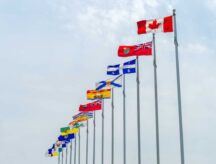Canada’s immigration ministers provide update on top objectives
The Forum of Ministers Responsible for Immigration (FMRI) has met again for its midterm meeting today in Halifax.
The meetings take place twice per year, and last occurred in Saint John, New Brunswick, on July 28.
The FMRI is comprised of federal, provincial, and territorial ministers responsible for immigration. The meetings act as a venue for the two levels of government to discuss Canada’s top immigration priorities.
In their last meeting, the ministers aimed to maximize the effectiveness of the immigration system to meet economic and regional needs, including increasing provincial/territorial (PT) involvement in the selection process.
Discover if You Are Eligible for Canadian Immigration
They also sought more input into Express Entry modernization and to increase the allocations of the PT Nominee Programs (PNPs). Finally, the provinces aimed to provide timely multi-year allocations before March 31st, 2023.
In today's meeting, the ministers spoke positively about the support for immigration in Canada and how they have been able to build on objectives outlined last summer.
Multi-year Provincial Nominee Program and Atlantic Immigration Program Plan
Notably, the ministers have endorsed the first-ever new multi-year Provincial Nominee Program (PNP) and Atlantic Immigration Program (AIP) plan. This plan will better help the provinces and territories outline their immigrant admissions and settlement in advance. Speaking on behalf of the provinces and territories, Arlene Dunn, the minister responsible for immigration in New Brunswick, said that provinces and territories are best placed to select economic immigrants. Minister Dunn said expanding the PNP, AIP and Rural and Northern Immigration Pilot will help reduce the IRCC backlog and improve processing times to better serve clients and meet their needs. The plan includes a 44% growth in PNP allocations for 2023.
The ministers also said that speeding processing times would help reduce duplication in the system, which in turn contributes to the backlog. They acknowledged the emerging challenge of finding affordable housing for new immigrants as well as current stress on settlement services nationwide.
The ministers are also looking for ways to enhance the process of obtaining an Educational Credential Assessment (ECA) or foreign credential recognition, by collaborating more with each other as well as stakeholders such as labour ministers, employers, and chambers of commerce. They highlighted key areas including in the selection stage, understanding the complex regulatory environment and advancing the quality of FCR pre-arrival information sharing. Obtaining an credential recognition quickly is a key step for a newcomer to practice their professionals at their full potential.
“Partnership, collaboration, and a shared vision for enhancing Canada’s immigration policies and programs are at the centre of how federal, provincial, and territorial governments navigate the everchanging immigration landscape," said Minister Dunn. "Through today’s meeting we looked to build momentum to further clarify the roles and responsibilities of our respective governments to successfully attract, integrate, and retain immigrants."
Shared jurisdiction over immigration
Since Canada was founded in 1867, the provincial and federal governments have shared responsibility for immigration. The main objective of these conferences is promoting the spread of immigration throughout Canada.
One of the main components of this shared responsibility is the Provincial Nominee Program (PNP). Each province, with the exceptions of Quebec and Nunavut, operates its own PNP through which candidates for permanent residency (PR) can indicate a preference to work and live in a specific province. Quebec operates its own immigration system.
If the provincial government believes the candidate can easily integrate into the workforce and support the provincial economy, they may offer them a provincial nomination. Getting nominated does not automatically mean that the candidate is a permanent resident, but it can strengthen their application to the federal government.
Ultimately, Immigration, Refugees and Citizenship Canada (IRCC) has the final say in how many candidates are invited to apply for PR under a PNP. Each year under the Immigration Levels Plan, IRCC outlines the national PNP admissions target. It then communicates individual PNP targets to each province and territory a few months later.
In the meeting last summer, PT ministers advocated for higher allocations due to labour shortages and a desire to have more control over the economic immigrants who settle and their ability to close their labour force gaps.
The Immigration Levels Plan 2023-2025 shows that PNP admissions will continue to outpace federal high skilled (Express Entry) admissions into 2025.
Provinces and territories hold immigration draws routinely. This week, British Columbia, Ontario, and Manitoba have held PNP draws, while Quebec held a draw under its own system.
Provincial immigration results March 4-10
British Columbia
British Columbia invited 276 candidates through the BC PNP this week on March 7.
229 were invited in a general draw that included tech occupations. The general draw took candidates from the International Skilled Worker with minimum SIRS scores of 100, and International Graduate streams with minimum SIRS scores of 105. Both streams included Express Entry candidates.
Entry-Level and Semi-Skilled candidates with minimum scores of 85 were also eligible for nomination.
BC also held occupation-specific draws for candidates in the Skilled Worker and International Graduate streams (including Express Entry. All required a minimum SIRS score of 60.
- 26 early childhood educators and assistants (NOC 4214) and;
- 19 healthcare workers
Ontario
Ontario held two draws this week under the Express Entry Human Capital Priorities stream.
The draw on March 9 targeted 822 candidates in healthcare occupations with Comprehensive Ranking System (CRS) scores ranging between 469-489. The second draw was on March 10 and targeted 815 candidates in tech occupations with a CRS range of 479-489.
Manitoba
Manitoba invited 576 candidates across three categories on March 9.
There was an occupation-specific draw for Skilled Worker occupations under National Occupational Classification (NOC) 2021 major group 65 (sales and service support occupations) as the province has identified this as a sector with high labour needs. The province invited 224 candidates under this stream with minimum scores of 612.
Manitoba also invited 277 candidates from the Skilled Worker stream with no occupation specified. These candidates needed a minimum score of 675.
Under the International Education Stream, there were 53 candidates invited with no minimum score. An additional 43 more candidates were invited as Skilled Workers Overseas with scores of 666.
Among the total number of candidates invited, 45 were also Express Entry candidates.
Quebec
On March 2 Quebec invited 1,017 candidates to apply for permanent selection through Quebec's Regular Skilled Worker program. The results of the draw were published this week.
The draw did not target any specific occupations and invited candidates with a minimum score of 589 points. Alternatively, invited candidates may have had a valid job offer outside the territory of the Communauté métropolitaine de Montréal.
- Do you need Canadian immigration assistance? Contact the Contact Cohen Immigration Law firm by completing our form
- Send us your feedback or your non-legal assistance questions by emailing us at media@canadavisa.com






